Page 8
The evolution of the Formula 1 racing car from the “Dino” style of car illustrated so nicely by the 1960 Ferrari Dino to the current “slipper body mid engine” style is a bit of a fairy tale and it is also a common sense, in your face, Trojan Horse. Look at the story carefully and you are set up to have some really inhibiting bozo barricades broken open! And just as everyone loves underdog stories that seem too good to be true, but are true, this evolution story is a pleasant “fairy tale”. And a true “fairy tale”. Even the term “fairy tale” can have two meanings. One pleasantly positive and another “fairy tale**” referring to a totally idiotic flight of fantasy!
To rehash terms; evolution is a real concept and involves personalities and creativity. When personalities think and create, a network is formed with one personality being influenced by other personalities and vice versa. Each personality learns from its creative efforts as well as learning from the efforts of others. Circular feedback is rampant. The creative products of the network of creative personalities develop and change, often for the better. And as the output of the personalities develops, in certain ways, so do the personalities themselves. That is the story of civilization. It is complex and event filled and interconnected and exciting. It is Life!
Evolution**, a term that gains credibility by being deceptively linked to evolution is a concept that doesn’t exist. Positive development of mechanical or biological products does not occur by chance. This is easy to prove in your workshop or on the kitchen counter or at your work place. Unless you apply a planning mind and apply some sort of productive force, nothing positive happens. Your wood working project doesn’t advance when you aren’t there working on it. The half made meal doesn’t complete itself when you are busy dealing with a phone call. The report or repair job at work seems to always wait for you to move it forward. Always!
I will do an experiment right now as I sit at my word processor key board. If positive creative events happen easily, I will test the “theory” and see how long it takes for one key of my keyboard to be depressed to further my writing effort, without me or anyone else touching the computer. - - - - - - - - - - - Okay, I am back at it. Forgive me for being so impatient and being so lacking in “faith” that that one key was going to miraculously depress without some creative personality being somehow involved. I know and you know that my house would have crumbled and the whole computer would have fallen apart before that simplistic positive event ever occurred.
Life and even mechanical integrity is either momentary or relatively close to momentary. 100 static years will bring most machines to uselessness. Ten minutes without a beating heart will bring your personal potential for positive “evolution” to an end. The concept of positive evolution** needs to be worded in eons in order to appear remotely “rational”. But eons are too long for life or even mechanical progress. Death is really quick compared to evolution**, and natural selection requires pre-existing living, units to compete . Natural selection**, like any nonexistent concept, isn’t even an issue. Nothingness requires nothing! Nothingness produces nothing.
And, again to rehash; notice in the upcoming Cooper Story how each idea or product that surfaced as being a winner was a product of a personality. Natural selection is real but natural selection** where some unplanned agent makes some other agent, planned or unplanned, obsolete due to survival of the fittest, never occurs. The battle between ideas and creative products and personalities struggling for mastery is fascinating. But no one worries about being upstaged by some imaginary apparition that lacks a brain and hands!
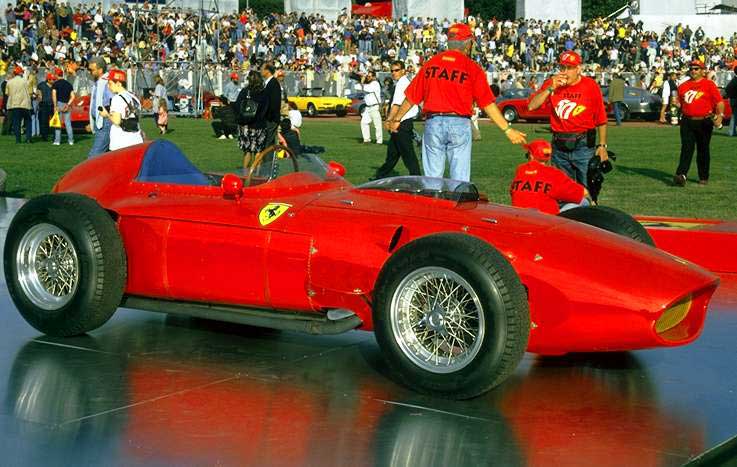

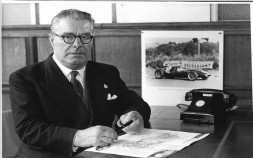
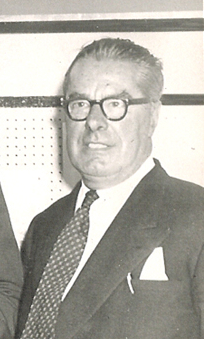
Charles Cooper was born in Paris. His father was a travelling actor and theatrical manager, originally from England. His mother was a Franco-Spanish lady who died shortly after Charles was born. Mr. Cooper senior moved back to England after his wife’s death and settled near London.
Charles junior, as his father’s name was also Charles, got a job as a mechanical apprentice at one of the Napier factories, not far from his home. The time was just before WWI and just when Brooklands raceway was new and humming. Selwyn Edge had linked Napier to Brooklands and to car manufacturing and young Charles found himself in the intoxicating brew! The actor and theatrical manager’s son found himself on the stage of a dramatic reality production. Charles, at this point had bit parts, but he was headed for stardom along with others. His roll would make the Cooper name well known in the world of auto racing.
The First WW stirred the pot, unexpectedly, and Charles enlisted, saw action, and survived. He was involved in mechanical work during the war, and after he was involved with selling reconditioned military motorcycles. His skills were developed further by the variety of experience and challenges. The next step was to set up an automotive garage in the London area. In 1923 his son John was born.
Due to his previous racing contact and his experience with motorcycles, Charles became involved with Kaye Don, an enthusiastic Brooklands racer and a challenger to the world land speed record.
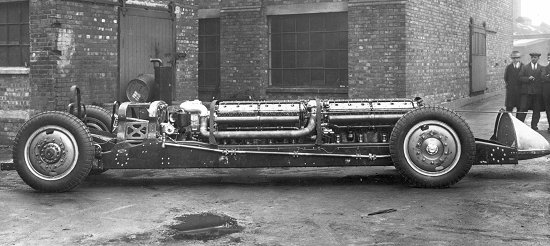
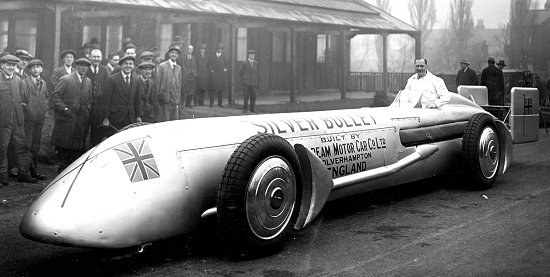
In typical father fashion, Charles also made a small car for John when his son was around 9 years old. A second special was built for John around 1936. The pattern was being setup. The path to the auto revolution was being unknowingly charted.
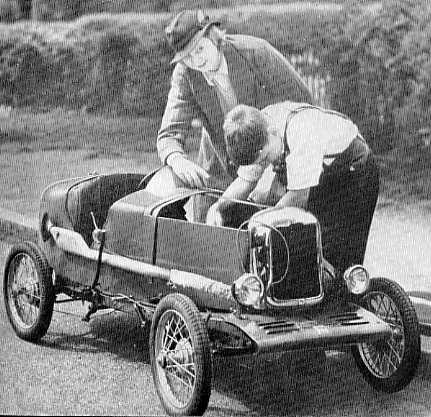
John departed for the Second WW and Charles kept the business alive repairing fire engines. The vital economic and creative base as well as the basic business sense that was going to be needed for the future grand push was being developed and maintained. In 1946, John returned and he and his friend Eric Brandon decided to get into racing in a newly created 500cc class. After making one car for John, the trio worked on a second car for Eric and the result was racing victories.
Charles had learned a lot about racing and his motorcycle interest factored in as well. The cars they created could be viewed as glorified go-karts, with the engine logically behind the driver’s seat where it was simple to connect it to the rear drive axle.
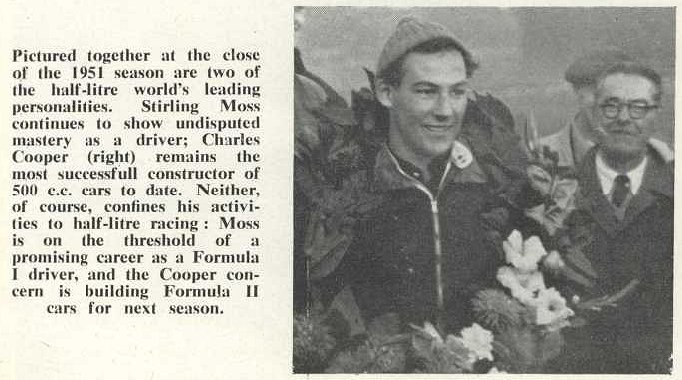
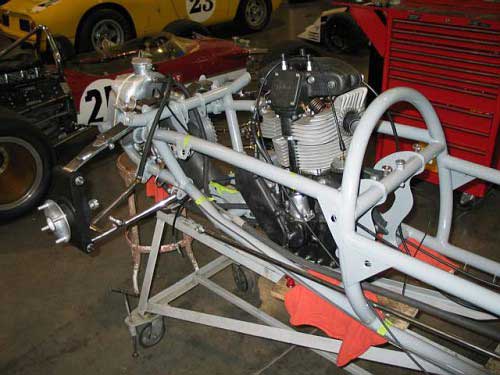
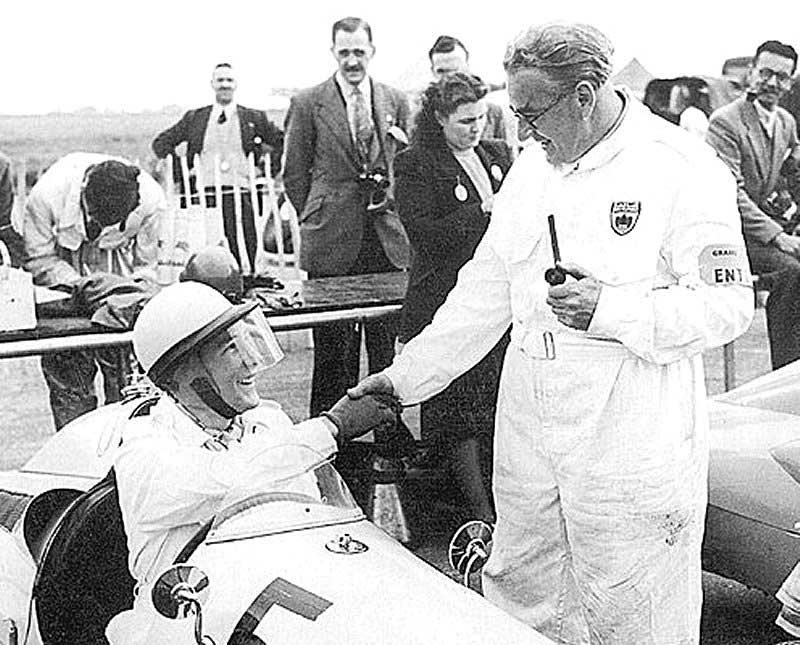
The little cars were generally well designed, had 4 wheel independent suspension, and won races. A young Stirling Moss was a buyer of one of the early Cooper 500cc cars. Due to the initial racing success, sales were strong, funds flowed in to feed the business, and there was a demand for cars with larger engines.
Engineering consisted of a lot of diagrams on shop walls and seat of the pants fabrication. But the success was anchored in Charles Cooper’s brain and fired by the youthful enthusiasm of John Cooper and Eric Brandon. Consider how the spirit of Montague Napier and Selwyn Edge and Hugh Locke-King (the push behind Brooklands) all factored into the flow of product out of the doors of the Cooper garage. Charles Cooper was one personality in the process. John Cooper claimed that the mid engine concept wasn’t great thinking – it just made sense for the 500cc cars with their motorcycle engines and the pattern was set. But brains and hands were at work, processing ideas and experiences. Time and chance was involved but nothing happened without some sort of link to one or more personality.
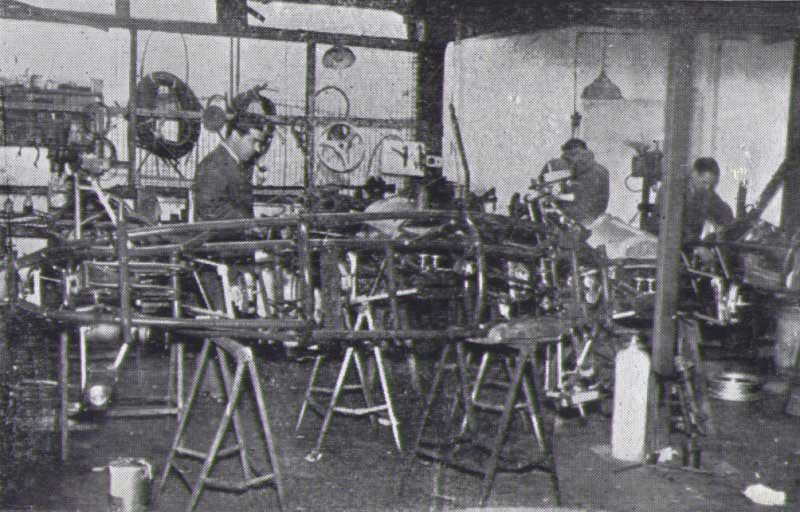
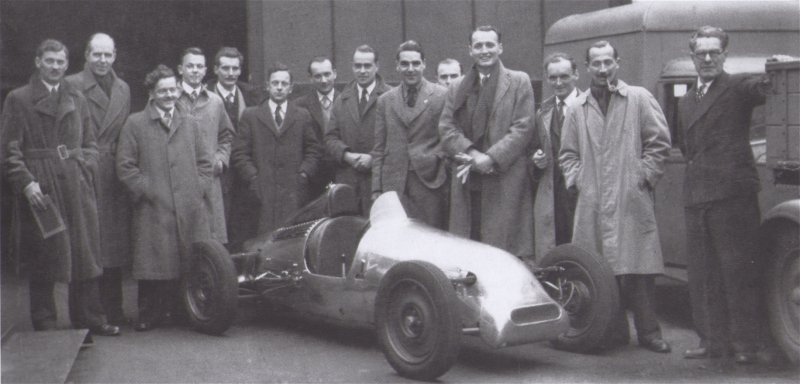
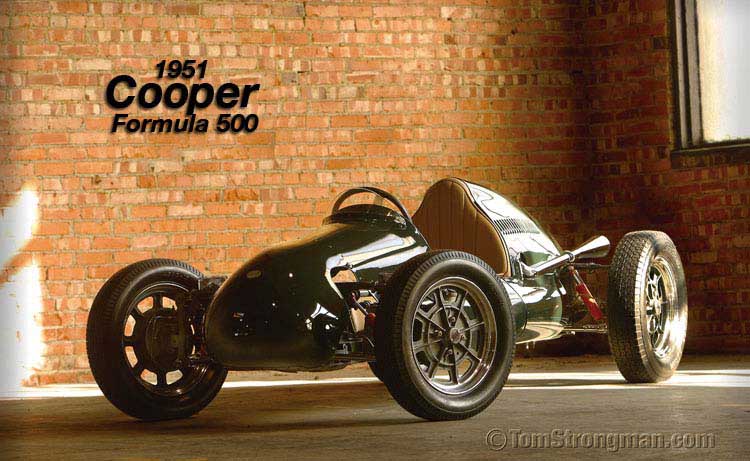
So the Cooper manufacturing operation was rolling and success and demand for products requires more manpower and more creative capability.
Owen Maddock was born two years after John Cooper. His father was an architect and Owen went into engineering. He was also a skilled musician and somewhat of an eccentric. His coverage in Wikipedia is amusing. Owen was a character! In 1948 he needed an engineering job as part of his final schooling degree and after being turned down by a couple of more established firms, Cooper took him on. Maddock just happened to be in a school close to the Cooper factory. Maddock was sort of a joe-boy due to the struggling nature of the new and growing Cooper mfging operation but he stayed with them and they put up with his somewhat prickly personality.
To illustrate the way the world interrelates, in 1954 Maddock designed a chassis for Tony Vandervell and the project was called the Cooper T30. Vandervell was out to put Britain into the front of the Formula 1 world and his cars were called Vanwalls, a play on his own name as well as his bearing company’s name which was Thinwall. Several more chassis were built to Maddock’s specs in 1955 but racing success did not come immediately.
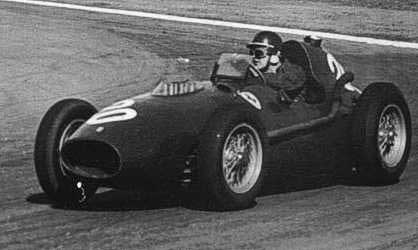
Then Colin Chapman, the man who would eventually propel the mid engine racer to new heights, worked the T30 over and the basic result went on to take the F1 World driving and manufacturing titles in 1958.
Meanwhile Maddock and the Coopers created a sports car called the T39 Bobtail. It was an early example of the ideas of Wunibald Kamm and could be seen as a modern F1 mid engine racer with the addition of a full body including fenders. But the driver sat in the center of the car, just as with F1 cars.
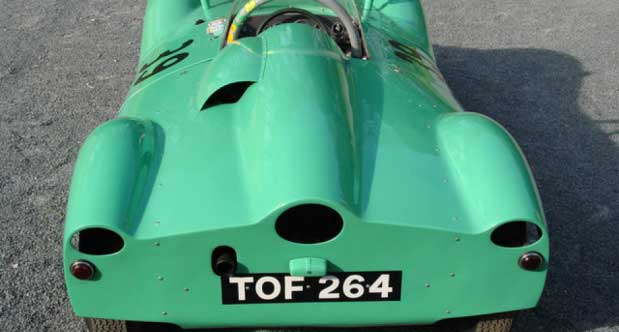
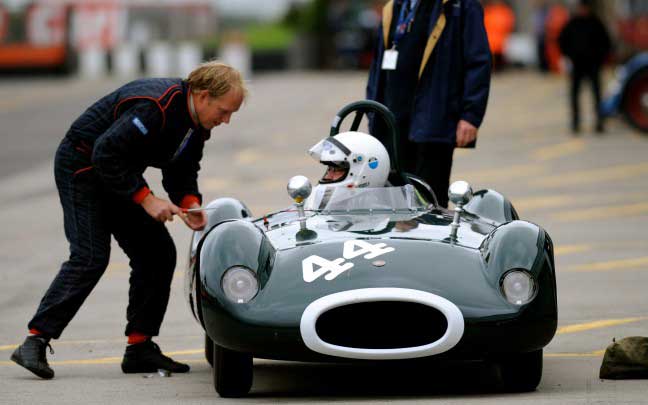
More personalities moved into the mix. Jack Brabham, an Australian had used Cooper cars in Australia and on moving to the UK he had increasing contact with the Cooper factory. He then proceeded to use a T39 chassis to create an F1 car for the 1955 season and went on to compete strongly and actually won an Australian F1 race. The win inspired Maddock and the Cooper operation to push a bit at an F1 car and one step lead to another and in 1957 Jack Brabham managed to get into third place in the Monaco GP prior to having a fuel pump failure. The determined Brabham pushed the car to the finish line and managed to come 6th.
In 1958, Stirling Moss drove a Cooper car to a win in the season opening Argentine Grand Prix. This was the first F1 Cooper win and the first time a mid engine car had won an F1 race. Brabham and Maddock did not get along well but even so, between the two of them, the development of the Cooper F1 approach was dramatic. They were onto a winning idea and between the two, with additional thinking from other players, step by step upgrades to the basic idea were achieved. A Cooper then won the 1958 Monaco GP.
Vanwall went on to win the 1958 F1 manufacturer’s championship and Mike Hailwood won the driver’s championship followed by Stirling Moss who, I believe, was only one point behind. But that was the end of front engine dominance. The era of the mid engine racer had begun.
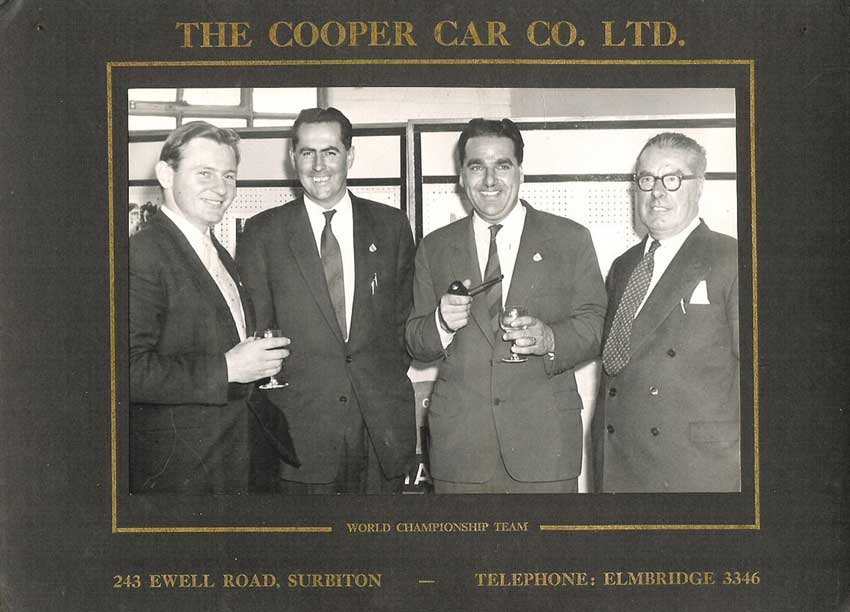
Between the Coopers, Brabham, and Maddox the winning formula was refined and in 1959 Cooper cars won 5 of the 9 F1 races as well as getting several other podium finishes. Jack Brabham won the driver’s championship and Cooper won the manufacturer’s award.
In 1960 Brabham again took the driver’s championship and Cooper took manufacturers.
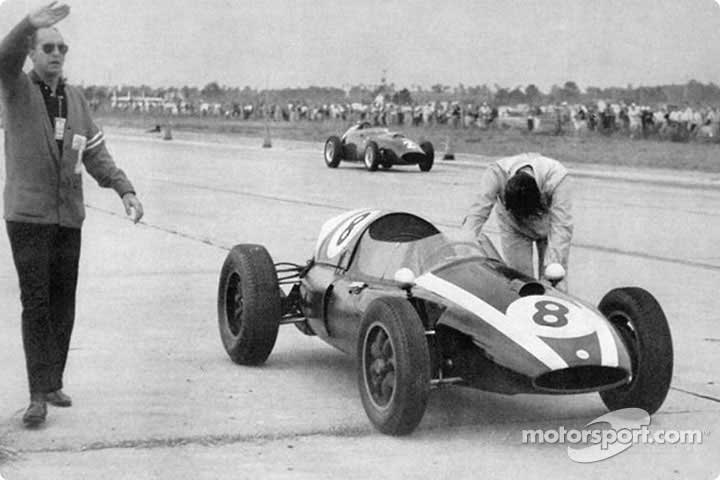
In 1961, engine displacement rule changes put Cooper cars out of the F1 running but Brabham took a tiny Cooper F1 car to Indianapolis. His 2.7 litre / 268 hp engine was up against 4.5 litre / 430 hp engines but he ran as high as 3rd and finished 9th. The writing was on the wall for the Dinos of the Brick Yard. Natural Selection was at work. What was at stake? Were there any mutations at work or miraculous design features that no one had any idea as to the origin of? A battle of minds was going on. Calculated experimentation and lessons learned, factored in. The front to rear turnover was the result of the interaction between physical principles and personalities. Even the spirit of Hugh Locke-King and Brooklands could be seen as coming across the ocean to shake up Indianapolis. Indianapolis was inspired by Brooklands and although Brooklands had closed in 1939, in 1961 Brooklands was again impacting Indianapolis. In 1965 the full force of the European Brooklands world would hit the American Brickyard.
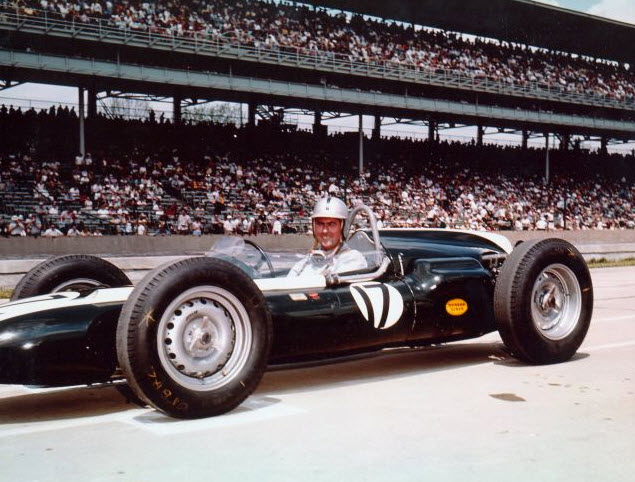
Brabham went on to establish his own manufacturing operation. Charles Cooper’s health declined and he died in 1964. Owen Maddox left Cooper in 1963 and went on to other challenges. John Cooper was not a business man and lost interest in the battle. The Cooper era passed.
Colin Chapman, who came from the same racing environment that the Cooper factory thrived in, went on to develop the Lotus car company. He also continued to develop the mid engine design. A Lotus came second in the 1963 Indianapolis 500. In 1965, Jim Clark driving a Lotus brought an end to the front end racing car reign at the Brickyard.
Charles Cooper was like a catalyst for the F1 revolution. His stable effort and business sense created a small space where a remarkable shift change was able to unfold.
Charles Cooper was involved with many of Kaye Don's racing cars including his Silver Bullet - a land speed contender.
The Silver Bullet never achieved its goal but Charles was learning about the world of racing cars.
John Cooper with the car that Charles built for him.
Above and below: Charles Cooper and Stirling Moss.
Above: The simple Cooper shop in the early days. Some established European racing operations had a degree of contempt for the simplicity of the Cooper effort but it became hard to knock winners!
Above: John (behind windscreen) and Charles on the right, with one of their cars outside the shop.
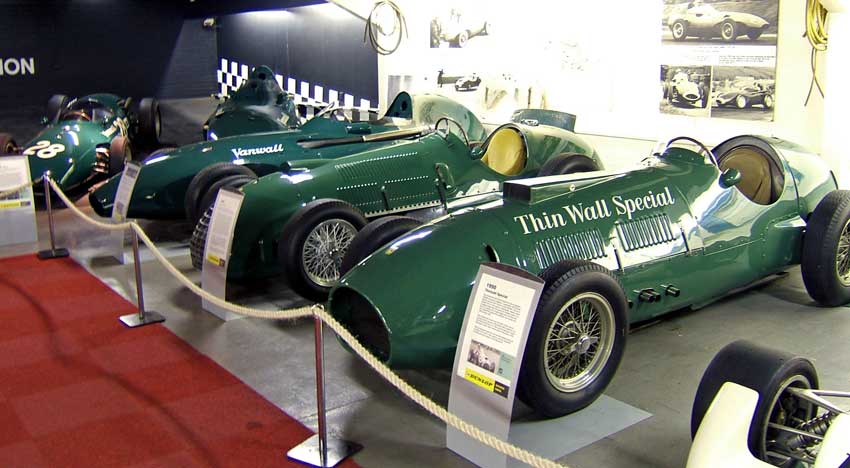
In 1958, Vanwall captured the Constructor's Championship in Formula 1 and drivers Hailwood and Moss took the Driving Championship first and second place.
Cooper T39 Bobtail. John Cooper didn't really like it and told people that they had cut the tail off so that it would fit in their cargo trailer.
Maddock was influenced by Professor Kamm to use the flat tail.
The winning team! There is little doubt that the 1959 Cooper / Brabham win was due to a team effort. Owen Maddock, Jack Brabham, John and Charles Cooper, and others all contributed to the victory. Bruce McLaren is on the left in the photo.
Jack Brabham pushed a car to the finish more than once. In 1959, after running out of fuel, his pushing effort at Sebring gave him a 4th place finish that clinched the World Championship for Cooper and for Brabham. I believe this photo shows the event. Brabham also gained a 6th place at Monte Carlo in 1957 in a similar "pushing" finish.
Jack Brabham at Indy 1961.
The engine position in the Cooper 500 set the pattern for the mid engine F1 revolution.
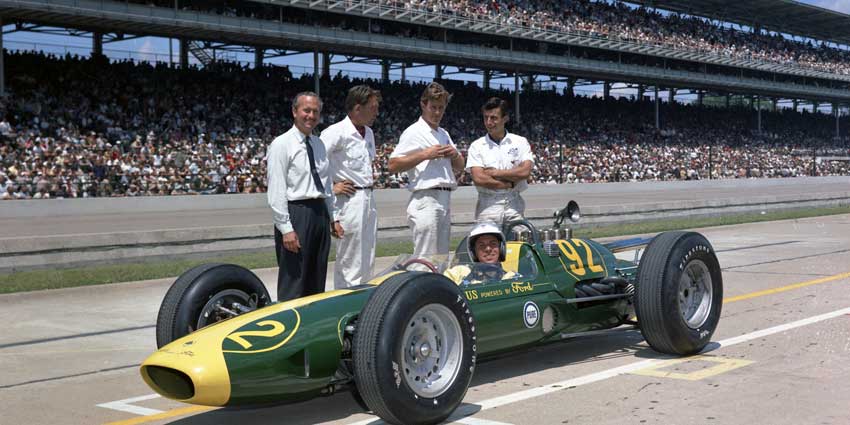
During the 60s, Jim Hall, a brilliant automotive designer and an impressive “all round guy” was busy with research instrumentation, aerodynamics, drive systems, and general car layout. He got into sports car racing as a university student, driving a California made car called a Chaparral. He and a fellow Texan named Hap Sharp launched into building their own cars which they called Chaparral 2.
Hall was a true innovator as well as having the sense to avoid killing himself. Here was a case of an American personality being impacted by Europeans and then having the results bounce back across the ocean. Hall raced F1 cars in Europe for three or four years, and saw what was going on there. He then returned to a shop and test track in Texas and generated creative product that had a major impact on Colin Chapman and on other European designers.
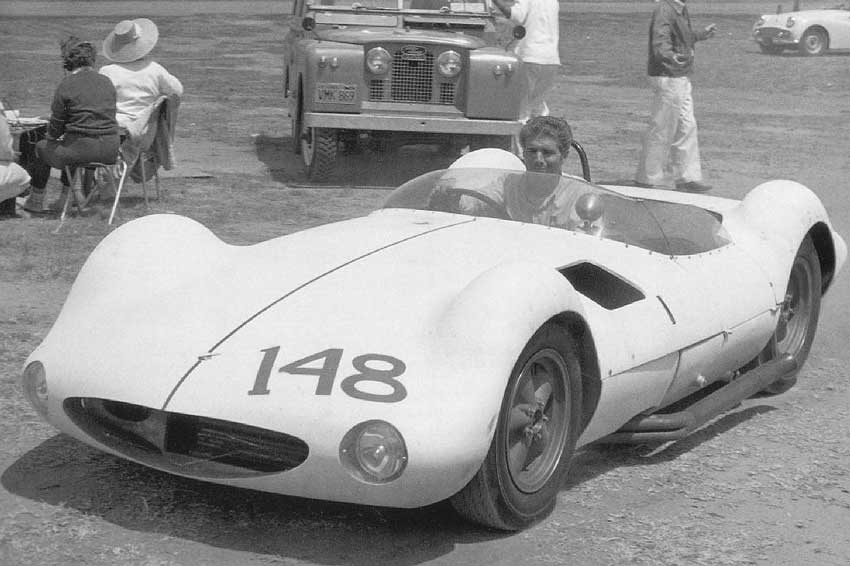
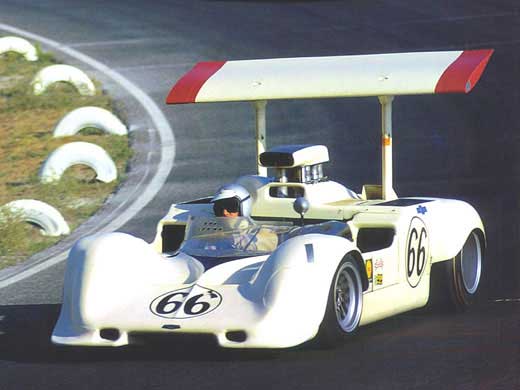
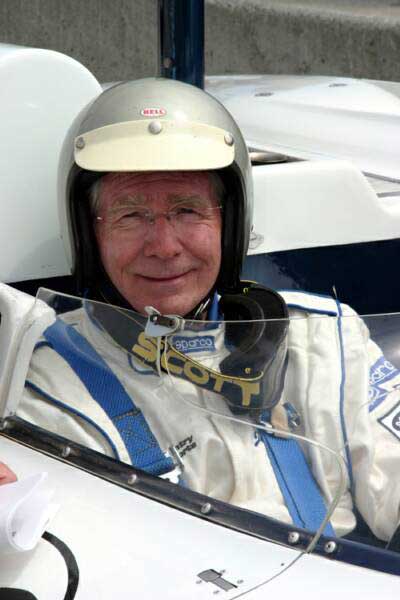
Hall appears to have started the use of wings to create downward pressure so that racing cars had more traction. That project morphed into body designs that created suction between the car body and the ground – the ground effect design.
Both Hall and Chapman pushed the ground effect movement ahead and were able to do so for a time without anyone realizing what they were up to. It is my understanding that Hall had the idea of putting the engine radiators on the sides of the car in order to give more aerodynamic leeway at the nose of the car. Chapman also used this trick and I am unclear on who was there first. Perhaps physical logic hit them both about the same time.
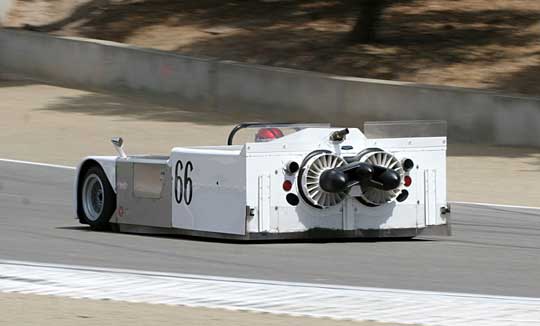
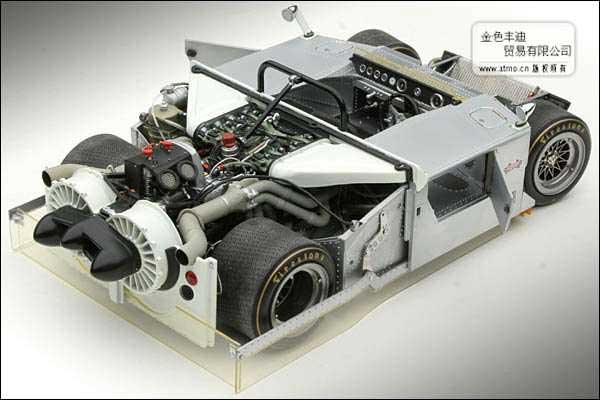
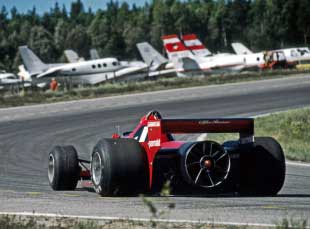
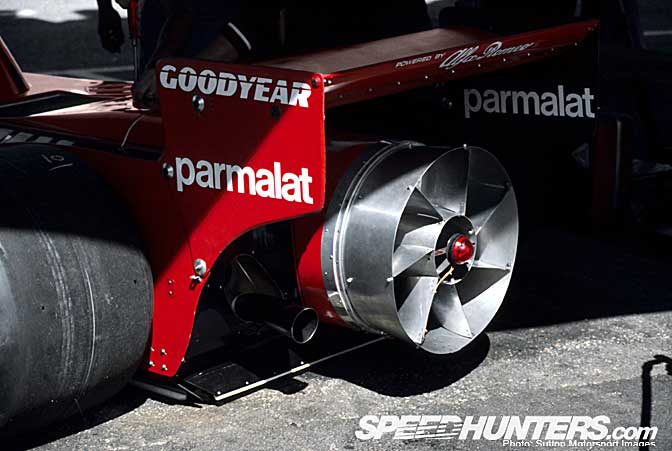
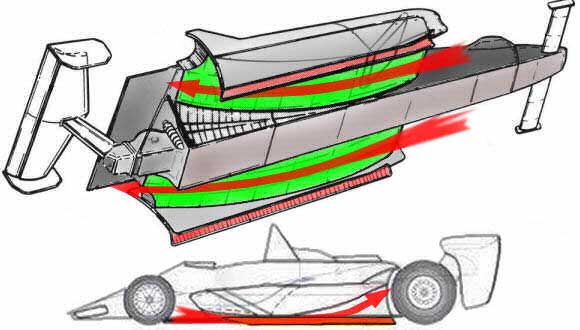
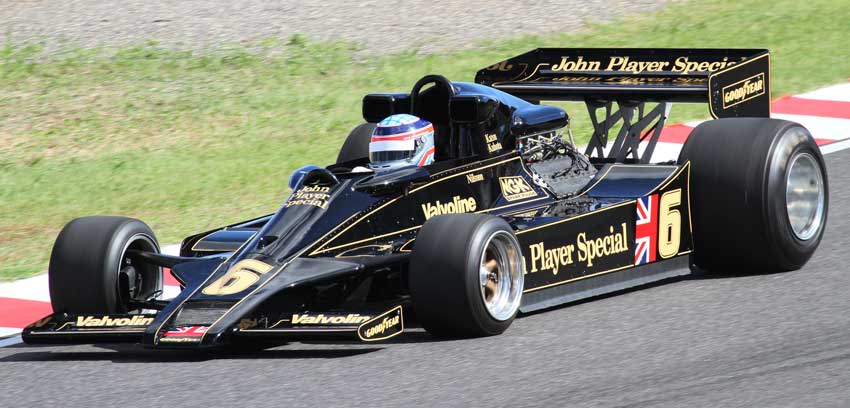
And I could go on and on. The evolution of racing cars since 1960 hasn’t slowed. And the micro world of auto racing is loaded with huge lessons just as is any creative field. And a neat thing about it is that we all have our noses up against the same immediate realities. We can get our brains in a knot and argue till we are blue about more distant issues but a glass of cold water on a hot day is pleasant for everyone. And “getting a job done”, right now, has the same feel and needed skills and pleasure of achievement for everyone. We all live on Planet Earth right now. Every living person experiences the same seconds and minutes. We are all in school together!
Now I am going to jump around to a variety of illustrations of racing “common sense” and other bits of day to day occurrence that screams for us to open our eyes to what is happening under our noses - to adjust our video screens so that we can see how to drive our car through life more successfully!
Colin Chapman was constantly pushing the envelop in order to produce winning racers. He was an advocate of achieving light weight because “adding horsepower made you faster on the straights but cutting weight made you faster everywhere”. There is some reason to feel that winning may have been more important to him than the lives of his drivers, but it is a tough call. Death in auto racing is nothing new and Chapman was clearly brilliant at riding a line between winning and mechanical and safety failure.
Lotus cars did have a reputation for being fast but flimsy. Stirling Moss lost a wheel on his Lotus at 140 mph. Shortly after he was presented with a cake that had a model F1 car on top and he requested that someone give Colin Chapman his piece of cake cut such that one wheel of the model was on the top of Chapman’s cake.
Chapman died unexpectedly at 54 from a heart attack in 1982. At the time of his death he and staff were working on “active suspension” for a racing car. Years later, Sir Frank Williams and his racing team used “active suspension” in the Williams FW14 and FW15 to win the 1992 and 1993 F1 manufacturer’s championship as well as the driving championship for Nigel Mansell and Alain Prost.
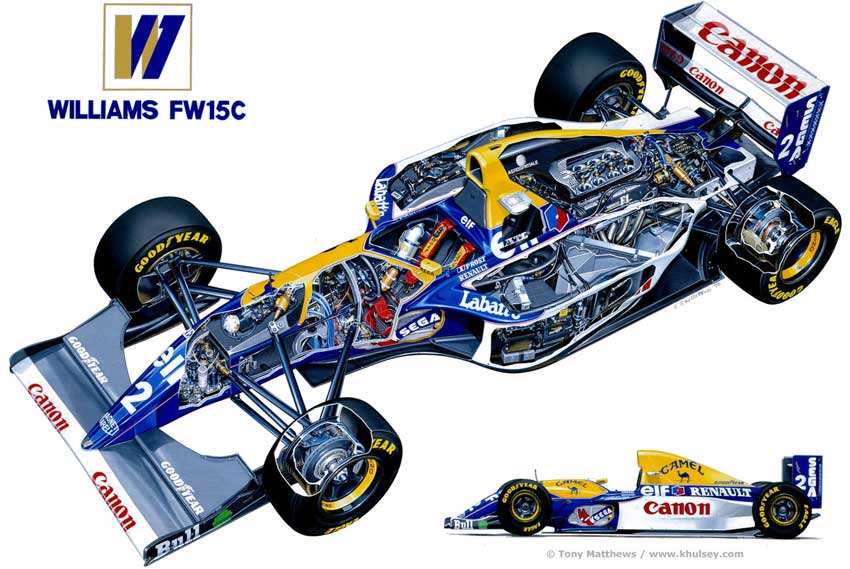
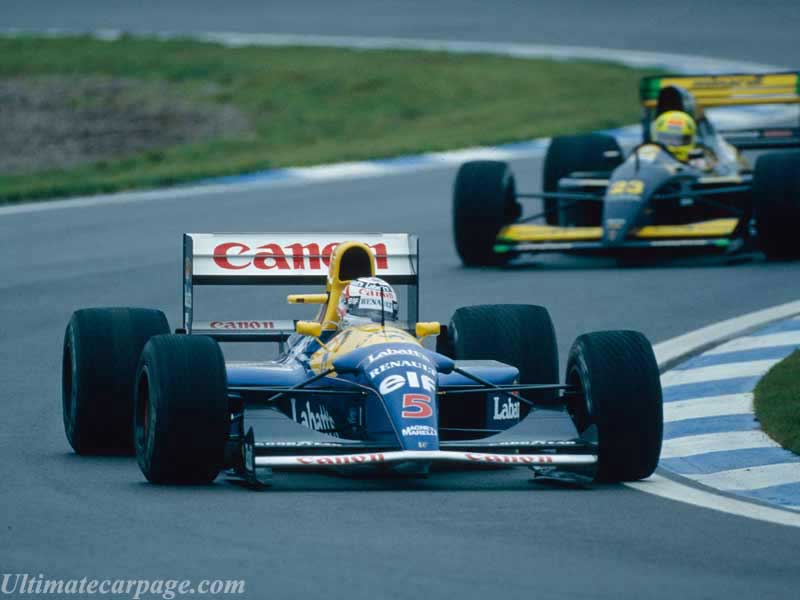
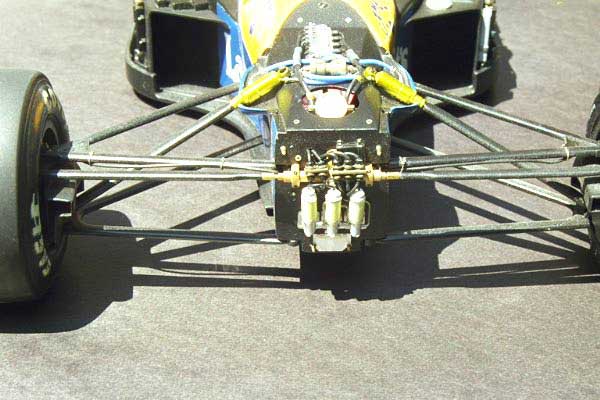
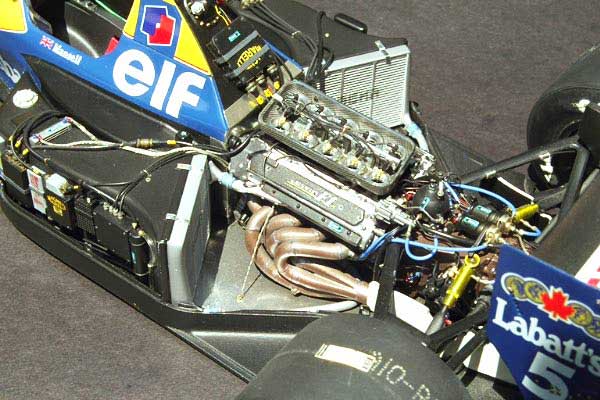
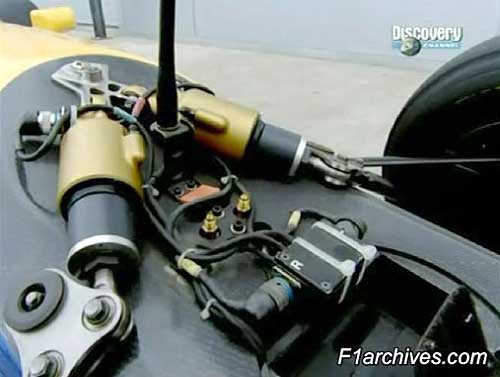
Colin chapman and Jim Clark effectively end the era of front engine race cars at Indianapolis in 1965. Look back a bit on this page and notice Jack Brabham's little Cooper in 1961. The evolution had progressed but that general shape is established.
Above: Jim Hall in his original Troutman & Barnes Chaparral 1.
Hall was an innovator! Wings, ground effect, fibreglass monocoque bodies, automatic transmissions, side mount radiators, and analytic instrumentation - pretty good driving skills and a skill at staying alive!
Hall is still alive and able to analyse and talk to people about his experiences. A great guy!
The Chaparral "ground effect" sucker car. Hall was short on time and funds to really develop the complex concept and rule makers quickly vetoed it from being raced.
A cut away diagram of the Chaparral Sucker car.
The photos to left and below show a suction car constructed by the Brabham racing team. The car was built to counter the ground effects Lotus 79. The Brabham team realized what Colin Chapman was up to with his winning model 79 but the engine that Brabham was using was too wide to allow the same body construction techniques that Chapman was using. The suction fan was used as an alternative method to get handling traction but was billed as a cooling fan. The car won a 1978 Formula 1 race before it was banned. Design smarts, purpose, understanding of phyical laws, interaction of personalities, competition, natural selection, and evolution were all at work. And as is always the case, roulette wheel evolution** was a concept that not only didn't enter the picture, but the very thought of such a concept would have been regarded as total idiocy by the shakers and movers in the Formula 1 arena!
Jack Brabham, the originator of the Brabham Team, died in May of 2014 at 88 years of age. His life was truly a Fairy Tale. He was the only man to have won an F1 Championship on foot (Sebring 1959) and the only man to win a Formula 1 Championship in a car that he constructed (1966). He was an important evolutionary personality. He was a teacher and an inspiration to all of us!
Photos above and below show the successful F1 Lotus ground effect car that used forward speed to generate air suction below the car. I believe Jim Hall was onto this trick first but Colin Chapman also used the idea with impressive success. As always, personalities were involved in the evolutionary process and the product of other personalities was pushed out of the winner's circle by natural selection. Hall used the ground effect principle to build cars that won at Indianapolis. The world is a small place with the spirit of Brooklands and the spirit of Indianapolis creating an intertwined flow of creative ideas.
The Williams FW15 illustrates how mechanical or biologic "machines" evolve in logical, integrated jumps - not in some smooth, almost unnoticed morphing progression. The "smooth progress" concept is a fairy tale**! The FW14 was a basic car to which were added reasonably integrated components including the active suspension system. But to do all the new "added features" justice, it was necessary to build a new car from the ground up in order to make a truly integrated whole. The FW15 was that project. It was so good that it was banned! Good designs are planned prior to construction and a creative mind, understanding of priciples, and experience, are what is needed to do the job. A roulette wheel has never won an F1 constructor's championship.
The FW14 and FW15 could be seen as the tragic killers of racing great Ayrton Senna. Senna had a strong desire to win races and he begged to be on the Williams team so he could benefit from their skills. Unfortunately two great competitors lucked out at the same time. Senna brought his driving skills to Williams just as Williams got clubbed down for being too good. Electronics were banned and suddenly the Williams cars that had been designed so brilliantly to use electronics, lost that tool. Senna was good but the casterated Williams car was a dog until the team could adapt to their hit. Senna tried to make the car a winner in the interim and died trying. What a sad story. But life is a stage and those of us still standing can observe and ponder.
Above: Here is a photo of "active suspension". Not much to see. Looks really simple compared to conventional suspension systems. Go for a walk. Toss a mechanical watch and an electronic watch on the ground. Which looks simpler. Which is easier to understand, as far as how it works? Which tells you about design skill and the power of the factory behind the creation of the watch? Hey! Notice the spider crawling on the ground by the watches! What does it have going for it with regard to electronics and chemical engineering and structural engineering? The point is that the front end of the Williams is a lesson on analysis. A lesson learned from eyeing that suspension system can be applied to a lot of other places. And the insight gained can improve your "driving" effectiveness greatly!
The electronic Williams cars were effective but not simple. I understand that it took three laptops connected to the cars to get them started up. Note the side mount engine cooling radiators - a concept introduced 30 years earlier by Hall and Chapman! It seems that natural selection has kept them in that location! And note the neatness of the entire machine. I design and build "things" and I know that that neatness does not come without thought and plannning and experience. As always, scratch the surface anywhere on the car and you will find a name of a person, not the serial number of a roulette wheel.
The front active suspension core on the Williams. It looks so simple!
The Williams cars were so successful that electronic control of F1 cars was banned. The systems were costly and racing was moving into a high cost field that put smaller budget competitors out of the running. Also, lapping speeds were climbing and safety became an issue if anything went wrong with the electronic controls.
The Williams cars were not flawless. The complicated nature of the machines meant that there was a lot of development cost and complications. In 1991, it was clear that the team was onto a potential winner but the less sophisticated McLaren car and the skill of Ayrton Senna won the year in large part due to reliability. Even in the winning years, the automated brains of the car would make errors that a human driver would have usually avoided. For the most part the advanced system could outdo a driver human, but humans are adaptable – to come up with an adaptable machine or robot is not a simple design job. And it is a design job! The Williams cars had A LOT of personalities and learning history and creative fire power behind them. Those high speed marvels were a tiny tip of an iceberg of creative effort. There is lots of internet illustration of at least some of what went into the FW14 and 15. Wow! A high tech army was fighting behind the scenes! The simple shop of the Cooper’s has been left in the dust and the Williams effort is blended into a worldwide economic and marketing system where any individual is only a small part – but inspect any facet, no matter how small, and you are going to find a creative personality revealed. There was lots of money. There was lots of marketing consideration. There was lots of Big Business involvement. There were hundreds and perhaps thousands of individuals involved. But there was not a spec of evolution** involved.
Any rational person can look at a 1959 Cooper racing car and at a 1993 Williams FW15b and they know that it was much more difficult to build the Williams than the Cooper.
There was clearly a greater understanding of physics and electronics. There was clearly more reliance on advanced tooling and techniques that had been developed over many years. The design and creative skills that were required to make the Williams were far greater. And none of that effort had anything to do with chance. It was all linked to deliberate creative effort – thinking and doing.
What is science and the scientific method? It is systematically figuring out physical laws and how they work and how they inter-relate. Getting an understanding of these matters is not simple and it takes a lot of systematic effort. But once you understand those laws, wow, the things a creative mind can do with the information is wild. If those laws weren’t totally reliable, we would have a serious problem. If the sun didn’t come up on time each day we would have a problem. Imagine a world where a day could be 10 minutes or 15 years. We would not be around to think about anything.


If electrons and radio waves did not follow consistent rules – as in VERY consistent, how could GPS or cell phones function. And unless we are clued into those rules - those realities - how do we have a hope of designing products that WORK. The scientific method involves getting in touch with reality. And thankfully we clearly are dealing with a reality that, as far as physical matter goes, is crazy reliable. As with the sun, if the rules of electrons varied continually, forget electronic design and computers.
It would be like trying to run a business where you have no idea when or if your staff will show up for work. You promise a vital client (you assume he is vital and reliable) that you will deliver a product on a certain date but unfortunately, for some reason that you do not understand, no staff shows up for a month. Alternatively the client could be a bull-shitter and never come to get or pay for the custom product that you made to his specs. Consistent rules are rather vital to achievement as well as to simple survival.
When we build anything, reliability of operation is critical. We have all owned products that intermittently fail to work. Let us be thankful that the laws of physics, which are linked to highly dynamic matter, are amazingly reliable. When we own an amazingly reliable product – a car – a camera – a computer – we are impressed with the design skill illustrated. We have all owned pieces of junk at some time. Someone, somewhere, be it an individual or a group of individuals, had it together when they made the winner. When we own a winner vs a loser, we appreciate the difference.
Lada cars were imported into Canada in the past. They seemed like a bargain as the purchase price was low. But jokes, based on personal experiences became common. Why does a Lada have a rear window heater? - So your hands don't get cold when you are pushing it! Why do you buy two Ladas at once? - So you have one to drive and one for parts! Honda Civics proved to be winners. Ladas faded from the market. Natural selection is real but you need at least two designed units for the quality control method to work. Defects or poorly suited units get weeded out but advancement of the design and major adaptation takes brains and productive capacity - not whimsical dreaming. Some ingeniously designed units, say finches, have adaptive capacity built in, but no design, not even a human, can self-adapt past certain limits.
The world is truly like an onion. Biologic life and manmade items all have complex and interconnected structure. Go a layer deeper and chemical laws and physics laws are structure related and integrated. The design of matter is little different than the design of items made out of the matter. Everything we know and can experience has structural complexity and displays the characteristics associated with any designed thing. Let us be thankful that the Lada design team was not responsible for our world! Design is always personality linked. It seems strange to not admire The Designer, especially when the credentials involved are linked to our very being and all aspects of our environment.
The scientific method is simply a way of clarifying human video screens so we can see what is happening in reality and then, thankfully, it seems that that reality is stable. We can aim at targets and hit them because the targets don’t move unexpectedly! We can achieve great things! We have been given minds and hands and a workshop with complex but stable rules. We are artists who have been given paint, brushes, and canvas!
Now, let’s look back at Darwin’s finches or plants that adapt to the weather conditions at various locations on the planet. Let’s look at what happens to white moths in Birmingham’s sooty atmosphere. Dark moths that are already around, tend to take over. The white moths don’t change. Let’s look at how you can have two dogs and work with that pair to produce a large variation of variety. But, hey, we don’t seem to be able to generate horses from the dogs. What about human’s ability to live in the tropics or at the poles? What if we didn’t have a system that can adapt to significant temperature changes? Is the change in animal coat colour evolution**? Obviously it is an ingenious design feature and not even evolution.
The Williams cars were able to adapt to bumps and speed variation and wet or dry track or going straight or going around corners in an incredibly effective manner that made them winners. Had they not been banned, they would have sent other cars the way of the Ferrari Dino. They spoke of brilliant design agents (Frank Williams, Patrick Head, Adrian Newey) but they had limits. Within certain parameters, the cars could seemingly evolve without a personality being involved. But we all know that in reality, personality and design brilliance was even more involved than was the case with the much simpler Cooper or McLaren cars. The brilliance of the designer was built into the product. The cars were blisteringly fast on pavement. How would they fare on mud or on a lake? They could automatically adapt, but only so far.
The Pikes Peak hill climb in Colorado has always fascinated me. The altitude change during the race is so great that it is important for engine carburetors to adjust to the change in air pressure. The same problem was encountered by aircraft and it took some time for designers to effectively deal with the problem. The mixture ratio of gasoline and air had to be altered as the air pressure dropped if engine power was to be maximized.

The Scientific Method has yielded all sorts of benefits and I have read books written in the 1920s that expressed the belief that our problems were over due to learning about such an approach. It may take a bit more to compensate for built-in human bozo circuits, but the method is certainly helpful when it is used! I have proposed some experiments and predictions and observations in this blog! The method is easy to apply.
When I was younger, as mentioned earlier in this blog, I wrote an article on snowmobile transmissions. I proposed a method of keeping engine rpm constant as the snowmobile sped up and I envisioned achieving this goal with purely mechanical means. The idea was a dumb-ass production that anyone with more experience would realize at first glance was nonsense. Would it have been wise to have called my idea a "theory" even though there was no way the idea would work?
Was I a complete idiot for thinking the way I did? The Williams F1 team developed a car with a transmission very similar to a snowmobile transmission that did indeed keep engine rpm constant while the car picked up speed, but they used electronics to achieve the goal. The impressive result was banned! Well, they did their part by trying!
I had a Grade 8 teacher who used to say that there wasn't such a thing as a complete idiot because no one is perfect. At Ieast I had the constant rpm part right. I wasn't a perfect idiot.
But to call a dumb-ass impossibility a "theory" is really a bit much! I am glad that I quickly realized that my idea didn't qualify to be gloried with a "theory" title. It was - - a dumb-ass idea - - - I pushed on!
The scientific method is wonderful but often it is over powered by the bozo circuits of the human mind!
We have enough emotion and "little child" built into us that quite often, even the scientific method gets shorted out.
Mark Twain apparently stated, with incredible accuracy, "You cannot depend on your eyes if your imagination is out of focus."
The material on this website shows how you can conduct simple experiments time and time again, testing the Theory of Evolution**, and always get the same clear result. Despite the solid results, many highly intelligent people are incapable of seeing the obvious lesson that their eyes have seen and their minds have been exposed to.